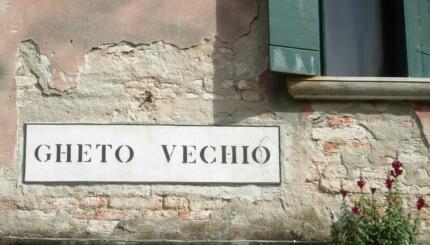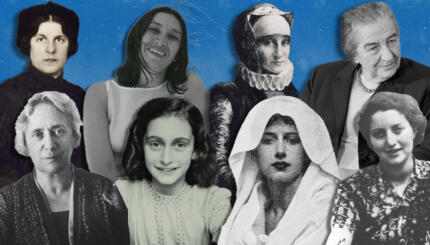The following article is reprinted with permission from the June 2001 issue of Sh’ma: A Journal of Jewish Responsibility.
For each home ground we need new maps, living maps, stories and poems, photographs and paintings, essays and songs. We need to know where we are, so that we may dwell in our place with a fullheart.
‑ Scott Russell Sanders
Whereas forty years ago there was but one Jewish museum of any consequence–the Jewish Museum in New York–today we encounter Jewish museums in most large American cities. I visited the Jewish Museum as a child, and recall that the old Warburg Mansion was then, as now, imposing, but the displays of Judaica were dusty and dull. Only one activity has stayed with me–casting for magnetized fish inscribed with didactic texts. Even 20 years ago, there were only seven museums that gathered to form the Council of American Jewish Museums (CAJM) under the auspices of the National Foundation for Jewish Culture.

Help us keep Jewish knowledge accessible to millions of people around the world.
Your donation to My Jewish Learning fuels endless journeys of Jewish discovery. With your help, My Jewish Learning can continue to provide nonstop opportunities for learning, connection and growth.
 Today, CAJM has a membership of about 60 professionally staffed museums and more than 100 Holocaust centers dot the landscape. What’ s more, these institutions represent an important effort to create “living maps” for our communities. Far from being cabinets of curiosities or warehouses of a dead civilization, Jewish museums in America are a vibrant part of contemporary culture.
Today, CAJM has a membership of about 60 professionally staffed museums and more than 100 Holocaust centers dot the landscape. What’ s more, these institutions represent an important effort to create “living maps” for our communities. Far from being cabinets of curiosities or warehouses of a dead civilization, Jewish museums in America are a vibrant part of contemporary culture.
In fact, Jewish museums in America are among the most conspicuous homes of the Muses, filled with history, literature, and dance, rhetoric, music, film, and theater–not to speak of and current affairs. Indeed, American Jewish museums are cultural centers, public forums, studios, workshops, discovery places, and sites of serious scholarship.
At the museum where I work, the Jewish Museum of Maryland in East Baltimore, we have adopted as our motto “New vistas on Jewish history, culture, and community.” But this might well define many other Jewish museums around the country, be they heritage museums, cultural centers, Judaica museums, or art galleries.
All too often, Jewish museums are thought of as warehouses of stuff or, at best, reservoirs of information in the form of texts, images, and objects. Yet the heart that beats in most museums is interpretation and public education based on “team scholarship.”
This scholarship, unusual within the humanities, combines the skills of several disciplinary experts, such as exhibition designers and media producers as well as scholars, curators, and editors. The result is often penetrating but accessible interpretation that is legible to diverse audiences.
Our museums are an arena of cultural activities that cut across lines of gender, age, ethnicity, background, class, and learning style. In Baltimore, a recent demographic study found that only one form of Jewish activity was engaged in equally by respondents identifying themselves as nonaffiliated, Orthodox, Reform, or Conservative: 60 percent of every category reported that they had visited a Jewish museum within the past two years. By every other measure, Jews of different affiliations differed markedly in their behaviors as well as their values. Jewish museums are an equal‑opportunity access point for the entire Jewish community.
Moreover, Jewish museums are increasingly becoming venues for non‑Jews to encounter Judaism, and are exploring many aspects of inter‑group relations. The Jewish Museum’s groundbreaking exhibition Bridges and Boundaries: Black‑Jewish Relations in America was a powerful, challenging experiment in public education. Its success was underlined not only by the large attendance inother cities where it traveled, but by the fact that in several cities African-American museums collaborated in its exhibition and programming.
Jewish museums are constantly experimenting with new cultural exhibits. The Jewish Museum of Maryland, for example, recently opened the first‑ever exhibition on “Tchotchkes! Treasures of the Family Museum.” Tchotchkes are small, mass‑produced, and seemingly trivial objects. Yet they carry substantial Jewish meaning. While some of our trustees wondered if we were going off the tracks, we comforted ourselves with the dictum attributed to the late Saul Lieberman of blessed memory: “Nonsense is nonsense. But the study of nonsense is scholarship!” When the African-American art critic of the Baltimore Sun reported that “you don’t have to be Jewish to love tchotchkes,” we felt justified in challenging the conventional wisdom.
Jewish museums across the country are commissioning and hosting extraordinary artworks, installations, and performances, full of energy, vision, provocation, exploration, and engagement. Our shared enterprise, despite the usual financial struggles and occasionally misguided efforts, is flourishing. The Jewish museums of America are, collectively and individually, helping us “to know where we are, so that we may dwell in our place with a full heart.”


